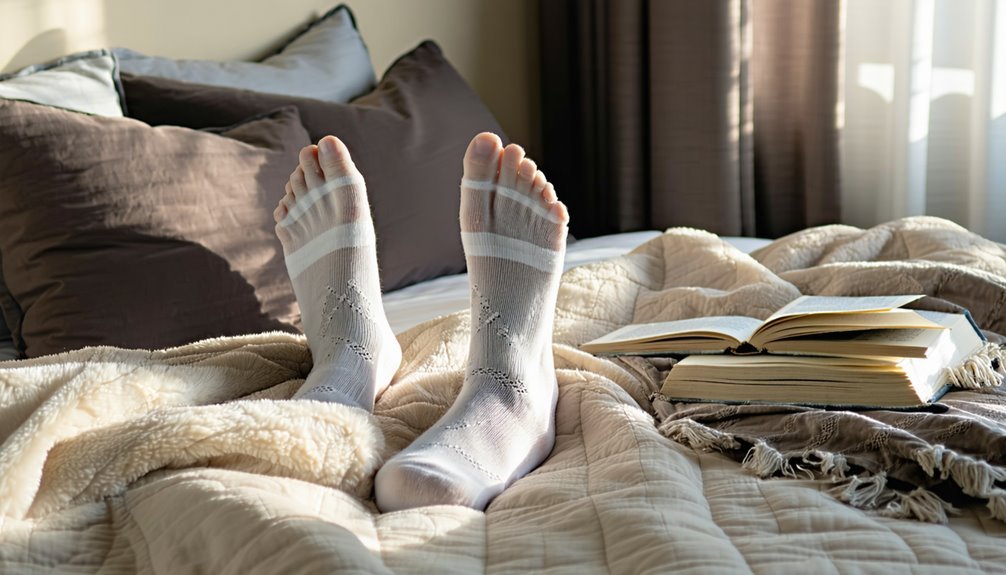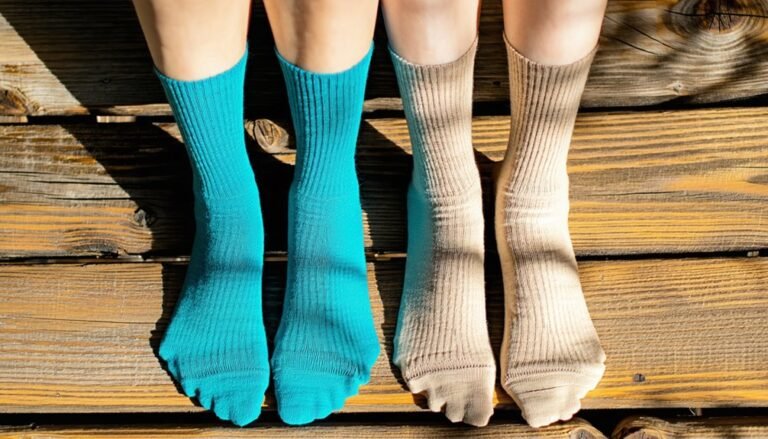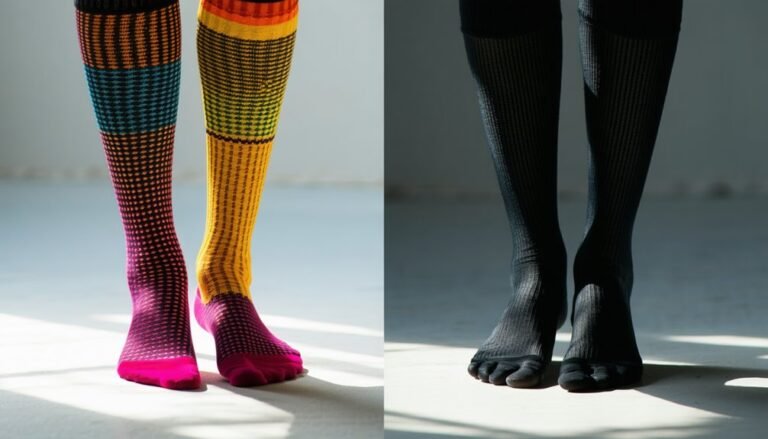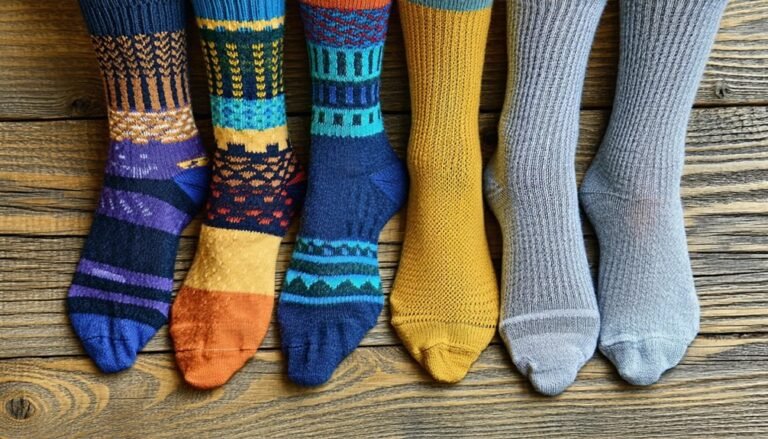Can You Sleep in Compression Socks?
You can sleep in compression socks, which are designed to promote venous return and alleviate swelling. It's important to choose breathable, moisture-wicking materials like nylon or spandex. Guarantee proper fit and mild compression level, around 8-15 mmHg, to avoid issues like restricted blood flow or skin irritation. While benefits include improved circulation and reduced edema, consulting a healthcare professional for personalized advice is wise. More insights can enhance your understanding of their effectiveness.
Understanding Compression Socks

Compression socks, an essential tool in therapeutic and medical settings, are designed to apply graduated pressure to the lower extremities. You'll find that these socks are crafted from advanced compression sock materials like nylon, spandex, and elastane, guaranteeing durability and flexibility. These materials facilitate precise pressure application, promoting venous return and enhancing circulation. The benefits of compression include reducing the risk of deep vein thrombosis, alleviating swelling, and preventing varicose veins. By maintaining ideal hemodynamics, compression socks help manage chronic venous insufficiency and improve overall vascular health. For those seeking safety and efficacy, evidence supports the use of compression socks in various clinical scenarios. Confirm proper fit and material selection to maximize therapeutic outcomes and minimize discomfort.
How Compression Socks Work
When you understand the mechanics of compression socks, you appreciate their role in promoting vascular health. Compression socks apply graduated pressure to the lower extremities, with the highest compression levels at the ankle, gradually decreasing up the leg. This gradient aids venous return, reducing blood pooling and enhancing circulation efficiency. The sock materials, often a blend of nylon and elastane, guarantee elasticity and durability, maintaining consistent pressure over time.
Evidence-based studies confirm that these socks help prevent conditions like deep vein thrombosis by optimizing blood flow. Selecting the correct compression levels is vital; too tight can impede circulation, while insufficient pressure won't provide therapeutic benefits. Always consult a healthcare provider to determine suitable compression levels for your needs, guaranteeing safety and effectiveness.
Common Uses of Compression Socks
Understanding how compression socks work lays the foundation for exploring their common applications. Compression socks are often utilized in athletic recovery to facilitate enhanced venous return and reduce muscle soreness post-exercise. By applying graduated pressure to the lower extremities, they help maintain ideal blood flow, which is critical for muscle repair and reducing inflammation. This evidence-based application supports athletes in achieving quicker recovery times and minimizing injury risks.
Additionally, compression socks offer significant travel benefits, particularly during long flights. Prolonged immobility can lead to venous stasis and increase the risk of deep vein thrombosis. Wearing compression socks during travel maintains circulatory efficiency and reduces edema, ensuring you arrive at your destination with minimal discomfort. Both applications underscore their role in promoting safety and physiological well-being.
The Pros of Sleeping in Compression Socks

Though often associated with daytime use, wearing compression socks during sleep can offer several physiological benefits. By exerting gentle pressure, these socks enhance venous return, improving circulation and reducing edema, or swelling, particularly in the lower extremities. This benefits overview highlights how enhanced blood flow during rest can potentially improve overall cardiovascular health.
In terms of comfort levels, modern compression socks are designed with breathable, moisture-wicking materials, ensuring you remain comfortable throughout the night. The graduated compression helps maintain proper tissue perfusion, which can be particularly beneficial for individuals with chronic venous insufficiency or those prone to leg swelling. While ensuring these benefits, it's important to select the appropriate compression level to match your specific needs, thereby optimizing both safety and effectiveness.
Potential Risks of Overnight Use
While compression socks can support venous return, wearing them overnight may impede ideal circulation if they're too tight, leading to potential discomfort or exacerbation of venous insufficiency. Prolonged use could also result in skin irritation due to moisture retention and pressure on sensitive dermal layers. Additionally, discomfort from improper fit or material can disrupt sleep quality, negating any perceived benefits.
Circulation Concerns Overnight
Although compression socks are generally safe for daytime use, wearing them overnight can pose circulation concerns. When you sleep, your body's natural mechanisms for blood circulation adjust, and prolonged compression can interfere with this process. This might impact your sleep quality and overall health. Here are some potential risks:
- Restricted Blood Flow: Continuous pressure may impede venous return, affecting lower extremity circulation.
- Nerve Compression: Excessive compression can press on peripheral nerves, leading to discomfort or numbness.
- Swelling: Paradoxically, tight compression may cause fluid accumulation, particularly if the fit isn't ideal.
- Pressure Sores: Prolonged pressure on certain areas increases the risk of skin breakdown, especially in those with compromised skin integrity.
Understanding these risks helps you make informed decisions about nighttime wear.
Skin Irritation Risks
Skin irritation is a significant concern when considering the overnight use of compression socks. Prolonged contact can exacerbate skin sensitivity, potentially leading to erythema or discomfort. Anatomically, compression socks apply pressure to the lower extremities, where skin is often thinner and more susceptible to irritation. Evidence suggests that individuals with pre-existing dermatological conditions, like eczema or psoriasis, are at heightened risk. Furthermore, allergic reactions to materials such as latex or dyes used in these socks can result in pruritus or dermatitis. Ensuring that the socks are hypoallergenic and properly fitted can mitigate these risks. It's essential to monitor your skin's response to prolonged wear and consult with a healthcare professional if you notice any adverse reactions.
Comfort and Sleep Quality
When considering the effects of compression socks on comfort and sleep quality, it's vital to recognize that their primary function is to enhance venous return by exerting pressure on the lower extremities. However, wearing them overnight can compromise sleep comfort due to restrictive sock materials. Potential risks include:
- Impaired Circulation: Excessive compression may reduce blood flow instead of aiding it, leading to numbness or tingling.
- Discomfort: Tightness from sock materials can disrupt sleep, causing restlessness.
- Skin Irritation: Prolonged wear may cause itchiness or pressure sores from continuous friction.
- Thermal Discomfort: Non-breathable fabrics might increase sweating, affecting sleep quality.
It's important to weigh these factors when deciding whether to wear compression socks overnight, prioritizing your safety and comfort.
Medical Conditions and Compression Socks
If you're managing varicose veins, compression socks can alleviate discomfort by enhancing venous return and reducing venous pressure. For individuals at risk of deep vein thrombosis, these garments can aid in preventing clot formation by promoting continuous blood flow through the lower extremities. Clinical studies support the use of compression therapy in these conditions, highlighting its efficacy and safety when used appropriately.
Varicose Veins Relief
For individuals seeking relief from varicose veins, compression socks offer a practical solution by applying graduated pressure to the lower extremities, thereby enhancing venous return and reducing venous pressure. These socks are an integral part of varicose vein treatments, providing effective compression therapy options. You might find that regular use alleviates symptoms and promotes vascular health. Consider the benefits:
- Reduced Swelling: Compression socks help minimize edema by improving circulatory efficiency.
- Decreased Pain: By supporting vein walls, they may lower discomfort caused by engorged veins.
- Enhanced Mobility: Proper compression can foster greater movement without the nagging ache.
- Improved Confidence: Knowing you're taking steps to manage symptoms can boost peace of mind.
Prioritize your well-being with these clinically-supported measures.
Preventing Deep Vein Thrombosis
In the domain of vascular health, preventing deep vein thrombosis (DVT) is crucial, particularly for individuals at heightened risk due to prolonged immobility, surgery, or genetic predisposition. Your body's venous system relies on adequate blood flow to prevent clot formation, which is where compression therapy comes into play. By wearing compression socks, you can enhance venous return, reduce venous stasis, and ultimately lower the risk of DVT. These socks apply graduated pressure, strongest at the ankle, tapering off as it moves up the leg, effectively aiding DVT prevention. It is vital to select the appropriate compression level and size to guarantee effectiveness and comfort. Consulting with a healthcare professional for individualized advice on compression therapy is highly recommended for maximum safety.
Expert Opinions on Wearing Them to Bed
While the idea of wearing compression socks to bed might seem unconventional, expert opinions vary based on individual health needs and conditions. Clinical evidence suggests that wearing them during sleep can aid venous return and reduce edema for some individuals. Experts recommend consulting with a healthcare provider to align with your specific needs. Personal experiences often highlight comfort and improved circulation as benefits, yet caution is advised.
Consider these important factors:
- Medical Conditions: People with chronic venous insufficiency might find relief.
- Consultation: Always seek expert recommendations to guarantee safe use.
- Comfort Level: Some find enhanced comfort, while others may experience discomfort.
- Circulatory Health: Positive personal experiences include alleviation of leg swelling.
Prioritize your safety by understanding the potential benefits and limitations before deciding.
How to Choose the Right Compression Socks

Understanding the importance of choosing the right compression socks can markedly impact their efficacy, especially if you've been considering wearing them to bed. First, consider compression sock materials. Opt for breathable, moisture-wicking fabrics like nylon or spandex, which enhance skin health and comfort during nocturnal use. These materials guarantee proper venous return and minimize skin irritation.
Next, pay close attention to sock sizing tips. Accurate measurement of your ankle, calf, and leg length is essential for ideal compression. Ill-fitting socks may cause venous stasis or even impede circulation. Consult size charts specific to the brand, as variations exist. Also, select appropriate compression levels—mild for nighttime wear (8-15 mmHg) is generally safe, promoting vascular health without undue pressure.
Tips for Safe Use While Sleeping
When wearing compression socks during sleep, make sure you select a proper fit to avoid compromising venous return or causing discomfort. It's important to regularly monitor your skin for any signs of irritation or pressure ulcers, as these can indicate improper fit or excessive compression. Evidence suggests that correct usage promotes microcirculation and can be beneficial, but always consult with a healthcare professional for personalized advice.
Choose Proper Fit
Selecting the correct fit for compression socks is vital for safe use while sleeping. Confirming proper fit minimizes risks like impaired circulation and skin irritation. First, consult a size guide to accurately measure your limb circumference and length. Precision is key to achieving the right compression level, which is essential for therapeutic efficacy. Remember, too-tight socks can constrict blood flow, while too-loose socks won't provide the desired benefits.
Consider these important factors:
- Compression Level: Opt for medically recommended levels based on your health needs.
- Sizing Accuracy: Use a size guide for precise measurements.
- Material Flexibility: Choose breathable materials to prevent overheating.
- Anatomical Fit: Confirm they contour well to your leg's natural shape.
Prioritizing these aspects fosters a safe and restful sleep.
Monitor Skin Health
Monitoring skin health is essential for safe use of compression socks while sleeping. Pay close attention to any skin changes, such as discoloration or irritation, which could indicate excessive pressure or improper fit. These changes may compromise the integumentary system's ability to maintain homeostasis. Make certain that moisture retention is minimized since trapped sweat can lead to skin maceration or fungal infections. Selecting socks with breathable materials can help maintain ideal skin condition. Regularly inspect your skin, focusing on areas prone to pressure, such as the calves and ankles. If you notice persistent changes, consult with a healthcare professional for an assessment. Prioritizing skin health when wearing compression socks overnight can prevent complications, guaranteeing both efficacy and comfort during use.
Alternatives to Wearing Compression Socks at Night
Although compression socks can be beneficial for circulation, there are several alternatives to evaluate for nighttime relief. These methods not only enhance venous return but also prioritize safety and comfort.
- Leg Elevation: Elevating your legs above heart level can facilitate venous drainage and reduce edema. Consider using a wedge pillow.
- Alternative Therapies: Techniques such as massage or specific yoga poses may promote blood flow and alleviate discomfort.
- Hydrotherapy: Warm baths or showers can dilate blood vessels, improving circulation without external compression.
- Loose-Fitting Sleepwear: Opt for garments that don't constrict, allowing natural lymphatic movement and reducing the risk of pressure-related injuries.
These strategies are evidence-based and designed to optimize circulatory health while ensuring restful sleep.
Frequently Asked Questions
Can Compression Socks Reduce Snoring or Sleep Apnea Symptoms?
Imagine a calm, quiet night where gentle breathing replaces disruptive snores. Compression socks may aid snoring reduction and sleep apnea management by improving venous return and reducing leg fluid accumulation, enhancing airflow and respiratory function, promoting restful sleep.
Are There Any Skin Reactions From Wearing Compression Socks Overnight?
Wearing compression socks overnight can sometimes cause skin irritation or allergic reactions due to prolonged contact. It's essential to monitor for erythema, pruritus, or dermatitis. Always choose quality materials and guarantee proper fit to minimize risks.
Do Compression Socks Affect the Quality of Sleep?
You might think compression socks could disrupt sleep quality, but evidence shows they enhance circulation benefits by promoting venous return. Anatomically, they reduce leg swelling, potentially improving comfort and safety during rest. Always consult a specialist for advice.
Can Pregnant Women Wear Compression Socks While Sleeping?
During pregnancy, you can wear compression socks while sleeping to enhance venous return and reduce edema. Improved circulation benefits fetal health, but guarantee proper fit to prevent pressure points. Consult your healthcare provider for personalized guidance.
Are There Special Socks for People With Diabetes to Wear at Night?
Did you know 34% of diabetics experience nighttime foot discomfort? Diabetic socks are designed for nighttime comfort, featuring seamless construction and moisture-wicking fabrics, promoting circulatory health while reducing pressure, ensuring you sleep safely and comfortably without irritation.







